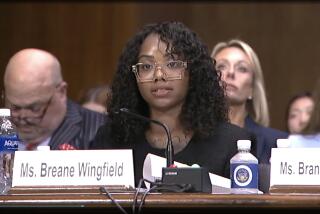Lawsuit Is Foster Center’s Legacy
- Share via
It happened on a warm July night nearly four years ago, but Jazzmon says she still remembers the sickly pop of her arm breaking and how the searing pain caused her to cry out and curse.
She had been sitting on her cot in a hallway at MacLaren Children’s Center, Los Angeles County’s home for abused and neglected children, when a staff member came by and told her to “get in position,” a disciplinary maneuver meaning that Jazzmon was to stand with her arms extended.
The next thing she recalls is being pinned to her bed by three or four workers, one of whom, she contends, had her right arm pulled against her back like a chicken wing before the bone snapped. She was barely 13.
Jazzmon, 16, is the lead plaintiff in a class-action lawsuit alleging that staff at MacLaren Hall injured scores of their charges while trying to restrain them. The county denies the charges and says incidents of children lashing out at one other and at staff members were far more prevalent than the reverse.
But last week, after years of intense criticism over its treatment of foster children, MacLaren closed with virtually no fanfare, part of a historic shift away from institutional care in the nation’s largest child welfare system
Now, in an unforeseen twist of fate, the children’s legal battle will outlive the institution they came to know so well and from which they are seeking redress.
The end was hastened by a separate lawsuit filed by the American Civil Liberties Union and other legal groups over treatment of children with emotional and behavioral problems. With MacLaren’s closing, the federal suit, which did not seek financial compensation, was settled Thursday.
Jazzmon R. vs. Los Angeles County and MacLaren Children’s Center, filed nearly two years ago and scheduled for trial in October in Los Angeles Superior Court, is likely to stand as one of the institution’s final legacies. The case seeks unspecified damages for Jazzmon, the five other youths named in the suit, and what it contends are more than 1,000 children physically or emotionally victimized at Mac- Laren.
And even with MacLaren’s closure, the lawsuit seeks other reforms in how the county treats foster children, including better mental health assessments and education.
MacLaren opened more than 40 years ago as a temporary refuge for children removed from abusive homes. Over the years, however, the El Monte facility acted more as a warehouse for as many as 300 children at a time. Some stayed years. Allegations of overcrowding, abusive restraint, overmedication and demeaning conditions prompted numerous legal actions and scathing reviews by watchdog agencies as well as children’s rights groups.
Jazzmon entered foster care at the age of 4 from a chaotic home, and among her many placements was a year at Mac- Laren. Her bed there was in a hallway, she said.
Recently, she has shuttled among a homeless shelter, a friend’s apartment and her grandmother’s San Bernardino home.
It would seem that she is anchorless, and she will tell you that is a sensation she has borne most of her young life.
“Right now I feel like the county can’t do anything for me that I can’t do for myself,” Jazzmon said in the Manhattan Beach office of her attorney. She is a tall, imposing girl, who speaks with articulate defiance. She still lacks full movement in her mended arm and said it throbs with pain when it is cold.
On the closing of MacLaren, Jazzmon said: “Thank God.”
Jazzmon and the other youths suing MacLaren -- identified in court documents only by their first names -- are poster children for the ills of the system that was supposed to protect them, their attorney said. They were put through a wringer of foster families, group homes, social workers and schools.
While disputing the allegations of staff violence, Assistant County Counsel Ada Gardiner said the county has offered in the past to settle the suit without admitting liability for the sake of the children’s well-being. She said the two sides have been unable to agree on a sum. (The children’s attorney, Sanford Jossen, said he felt the offers to the children, about $5,000 each, were inadequate but that he remains willing to explore a settlement.)
Gardiner noted that many of the children sent to MacLaren were troubled and brought behavior problems with them. A major task of the staff was to keep them from harming themselves and one another, she said.
The lawsuit alleges that the staff falsely accused many children of assault and that many youngsters, including Jazzmon, ended up in juvenile hall or probation camps.
Excessive restraint was used to control the children, many of whom suffer from mental and emotional disturbances and physical handicaps, according to the lawsuit.
Felicia B., who was 16 at the time and is developmentally disabled, was injured when staff members tried to prevent her from using the bathroom, pushing her face into a table edge “with such force as to knock out one of her front teeth,” court documents allege.
In another incident, Melanie D., who was 14, was allegedly taunted by staff, who called her “white trash” and punched her until her face was black and blue, according to the suit.
“Unfortunately, sometimes these kids have logical, even predictable, reactions to illogical and unacceptable circumstances,” Jossen said. “The reaction may seem when isolated to be aggressive or difficult, but when one looks at the life experience these kids have in the system, it’s a wonder they’re not even more aggravated.”
County Department of Children and Family Services interim Director Marjorie Kelly, while declining to address specific allegations, echoed Jossen’s assessment that many children were left adrift in the system, resulting in depression and anger.
“Kids won’t act out if we attend to their needs for stability, family and nurturing and we’ll also remove issues that have led to some of the activities that have resulted in lawsuits,” Kelly said. The county’s goal is to help troubled families remain intact if possible or place children with relatives or even family friends rather than strangers.
Jazzmon could recall nothing good about her MacLaren experiences, but that is not the case with everyone, said Deanne Tilton Durfee, executive director of the nonprofit Interagency Council on Child Abuse and Neglect, which, while unaffiliated with MacLaren, has been housed at the El Monte facility nearly 25 years.
“I’ve had kids call and say their fondest memories in a very turbulent life were at MacLaren, where they felt most secure,” Durfee said. “I didn’t find it to be the snake pit it is frequently described as, but I also found things I didn’t like over the past 25 years. Many of the staff are really good with the kids and some are not so good. But you’ll never have a consistently loving, warm and structured environment in a 24/7 institution.”
Jazzmon and other children described MacLaren as more restrictive than protective, with little opportunity to leave the grounds. Children attended school at the facility and ministers were brought in for worship. Their days were highly regimented: school, set mealtimes and recreation breaks and an early lights out, punctuated infrequently by visits with family members and occasional outings to movies.
It was an expensive institution to run, $275,000 annually in total costs for each child, according to a recent grand jury report. That compares with an estimated average $14,400 for a child in a foster family or group home.
Ruben B., 16, another of the children suing the county, wondered what he could have done with $275,000.
“I could have helped my family out,” he said, during a recent visit downtown. He has curly dark hair and an expression that is sometimes intense, sometimes mischievous.
He entered foster care at the age of 7 and has been in the system permanently since 13. About two years ago, Ruben suffered a broken arm and damaged tendons while several MacLaren staff members were trying to restrain him after an argument, according to court documents.
Afterward, Ruben shifted frequently between foster homes and MacLaren. He often ran away from MacLaren and stayed on the streets rather than be forced to take medications, he said.
When he was placed in MacLaren, he was diagnosed as emotionally disturbed and needing enhanced supervision, according to the suit, which also charges that many children like him never received appropriate mental health assessments.
“They keep telling you things about yourself ... and being 14 years old, you begin to believe it,” he said.
Neither Jazzmon nor Ruben described their stays in foster homes as being much better. When Jazzmon was young, one foster mother beat her, she said. Her goal is to become legally emancipated so that she can live on her own.
Ruben was recently placed in a new foster home and said it is too soon to tell whether he will like it.
He wants to attend college, but said he is two years behind in class because the continuation school he attends won’t accept his MacLaren credits.
“I hate the foster care system. I can’t stand the system, but I’m in it even though I don’t want to be,” he said. “I see the little kids coming into it and I think to myself: ‘Wow, you’re about to go through so much stuff.’ ”
More to Read
Sign up for Essential California
The most important California stories and recommendations in your inbox every morning.
You may occasionally receive promotional content from the Los Angeles Times.











